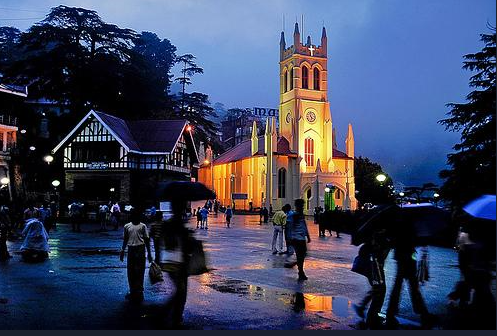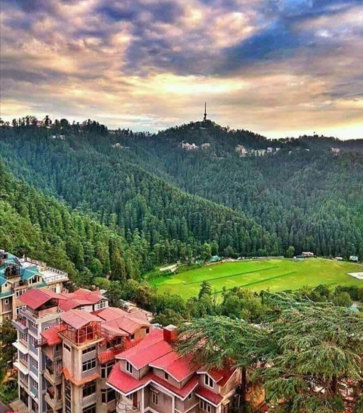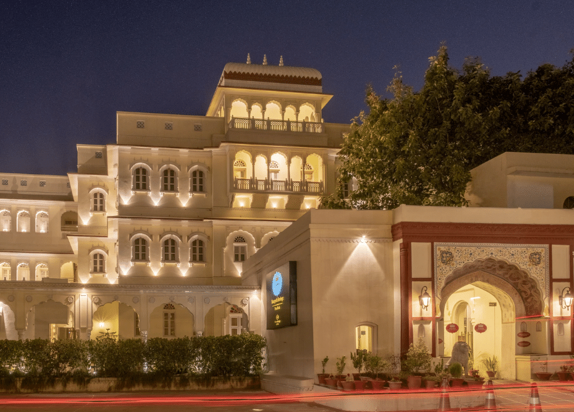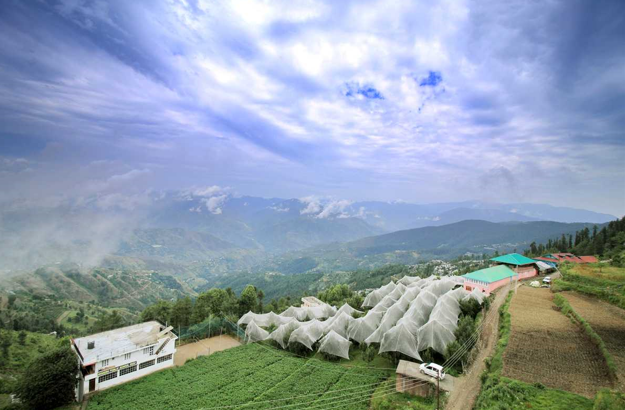Shimla
Shimla is a destination that needs no introduction. A quaint little hill station accessible by a toy train ride on the foothills of the Shivalik range is perhaps one of the most recognized hill stations in India. Established by the British as a means to get some respite from the scorching Indian summers. Shimla has today become a popular tourist spot.
The 12 kms. crescent shaped ridge in which it is located was first occupied by the British troops in the early part of the 19th century during the Anglo Gurkha War. It was once the part of Nepali kingdom and called Shyamata another name for the goddess Kali but received few visitors until it was ‘discovered’ by the British who were seeking respite from the baking plains in 1819. Three years later, the first ‘British’ house was erected and in 1864 Shimla become the summer capital of India. Even now, it holds the lingering echoes of a bygone era. Shimla’s salubrious climate easy accessibility and numerous attractions have made it one of the most popular hill stations in north India. The splendid views of the snow-clad ranges of the Himalayas dine walks through oak and flowering rhododendrons enchanting resorts within easy reach golf at Naldehra and skiing at Narkanda make Shimla an attractive destination throughout the year.
Shimla Sightseeing
Rashtrapati Niwas:

Rashtrapati Niwas is a palatial building near Summer hill outside. It has sprawling lawns a well laid out garden ancient trees and exotic flowers inside it has wooden paneling with Burma teak. It is resplendent with India’s colonial history.
Himachal State Museum and Library:

About 2.5 kms. west of Scandal Point near the communications mast, the museum is located in a colonial building ser amidst spacious lawns. It has a good collection of statues, Pahari miniatures, textiles, coins, photos, stone sculptures local handicrafts, embroidery and other items from around Himachal Pradesh and is worth a visit. Photography is strictly prohibited.
The Glen:

About 4 km. west of the Scandal Point is one of the former playgrounds of rich British colonialists. Now it has become a picnic spot.
Christ Church:

The second oldest church in northern India (the oldest is in Ambala). Christ church was built between 1857 and 1864. The church is one of Shimla’s major landmarks and is renowned for its stained-glass windows. James Ransone designed the Library next door int mock Tudor style.
Annandale:

Follow the first part of the route as for the Glen and continue down along the metalled road to this large glade surrounded by deodar woods. The turnoff is on the way to the museum and goes through Annandale another lovely area. This was the site of a famous racecourse and cricket and polo still played there.
The Mall:

All visitors to Shimla inevitably walk down the Mall, the main promenade that runs along the toop of the ridge a busy shopping area with old colonial buildings souvenir shops and restaurants. At the top end of the Mall is scandal Point, a large open square with a view of the town a favourite rendezvous for visitors and the local people. Overlooking it is the elegant Christ Church with its dine stained glass windows.
Jhaku Hill:

The steep climb to Jakhu Hill. Shimla’s highest point is rewarding for there are superb views of the town and its surrounding. At the top there is a temple which is dedicated to Hanuman. This temple is known as Jhaku Temple.
Chadwick Falls:

Beyond Summer Hill is the 67 mts. Waterfall cascading into a deep gorge. The falls are best seen after the monsoon.
Prospect Hill:

A 15 minute climb from Boileauganj. Prospect Hill is another favourite walk and vantage point with breathtaking views. There is a little temple to Kamna Devi on the top of the hill.
Sanjauli:

A serene location with delightful walks. Sanjauli is ideal for a tranquil weekend. There are dine cistas and the lights of Shimla and Chail can be seen twinkling at night. On the other site Mashobra and Naldehra are visible.
In the around Shimla District:
Sainj Basa:

On the Theog-Chhaila Road. A typically Pahari structure huge and impressive. It stands in an 80 feet high platform. It is the residence of the Rana of that area has old world charm.
Devri Khaneti Fort-Palace:

Khaneri a small and secluded village with the landscape replete with apple orchards has a palace built on a rock. It is about 500 years old and added to that speaks for its different portions looking different.
The palace of Sarahan (Shanti Kunj):

Sarahan, which used to be seat of the Rampur Bushahr kings is just 40 km. from Rampur famous for its magnificent Bhima Kali temple which is a like tower-like structure displaying the Pahari style of architecture.
Ranzore Palace:

It is currently the residence of the members of the erstwhile ruling family. The palace faces the Chaugan. The façade is massive and intricately painted.
Another palace is Ran Vijay Palace. The palace is spread lengthwise with lawns and fountains, trees and flowerbeds and is almost like any European mansion. It has four huge drawing rooms which were used according to the status of the guests. At the back of this palace is the ancient tree where it is said Baba Banwari Das sat in meditation when Raja Karam Prakash saw him.
The Palace complex contains four temples. The Shiva temple once had exquisite painting on its outer walls which are blurred now with time and disuse.
Kufri:

A wide spread of snowpeaks, deep valleys and position as a mist do excursion from Shimla have ensured Kufri’s popularity down the decades. This was the place where skiing originated in Himachal Pradesh and today this remains popular for its walks, horse and yak rides, drives of the famous Chini Bungalow and provides a resting and refreshment point for spending the day in the area.
Fagu:

Fagu is a tiny village that rests astride a mountain saddle along the Hindustan Tibet Road. The location gives it is a rare range if views that encompass both its northern and southern valleys and the snowclad peaks of the Greater Himalaya. In the open patches, the valleys hold tiny hamlets, orchards and neatly terraced fields while the area is covered with forest of deodar (Himalayan cedar) and spruce.

I really like what you guys are usually up too. This type of clever work and reporting! Keep up the amazing works guys I’ve included you guys to my personal blogroll.